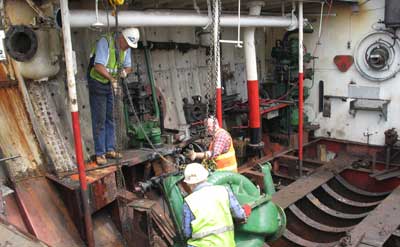TST LYTTELTON II
The T.S.T. Lyttelton II was a harbour tug with a length of 38 metres, beam of 9 metres, draught of 4 metres and displacement of 604 tonnes. Her twin props were powered by two triple expansion steam engines each with an indicated horsepower of 625. Her two scotch marine boilers were coal burning with forced draught.
In 2006, when all options for keeping the vessel afloat had been exhausted, the club decided to use its accumulated funds to save the entire engine room. The engine room was seen as a time capsule with virtually nothing altered since the tug was launched in 1938.
Currently the engines have been restored and are on display in bay 5 of the main shed. The rest of the engine room, including the hull down to the deck plates and all piping and fittings can be found around the site. The boilers and other sundries like the propellers and anchor have also been retained.
 Lobnitz bought in the rest ofthe engines and pumps from local manufacturers. The tug had 17 steam engines and pumps in total.
Lobnitz bought in the rest ofthe engines and pumps from local manufacturers. The tug had 17 steam engines and pumps in total.

 1987 Sold to a Geelong enthusist and steamed to Port Phillip bay
1987 Sold to a Geelong enthusist and steamed to Port Phillip bay

 See them in action on the last Sunday of the month.
See them in action on the last Sunday of the month.

 This pre WWII ship had no communication cabling. Copper voice tubes connected the bridge to the engine room.
This pre WWII ship had no communication cabling. Copper voice tubes connected the bridge to the engine room. Mechanical links via chains reflected the engine revs etc up to the bridge.
Mechanical links via chains reflected the engine revs etc up to the bridge.